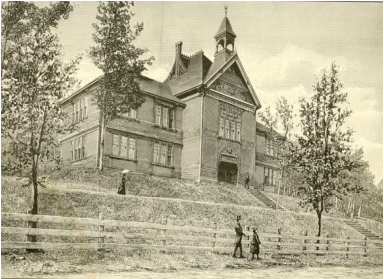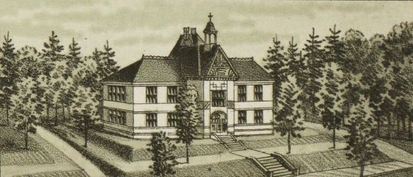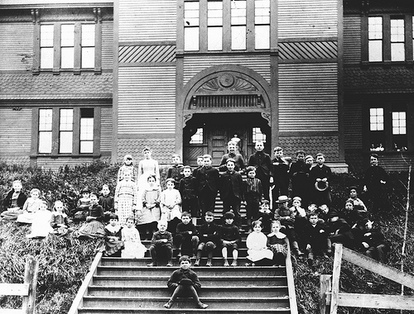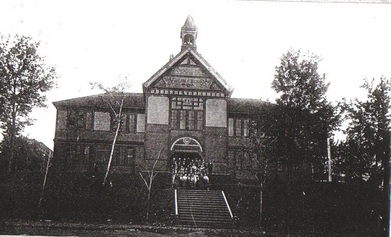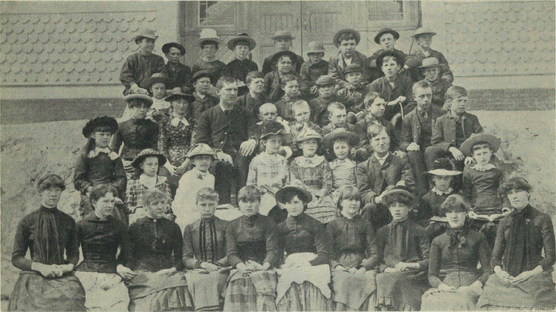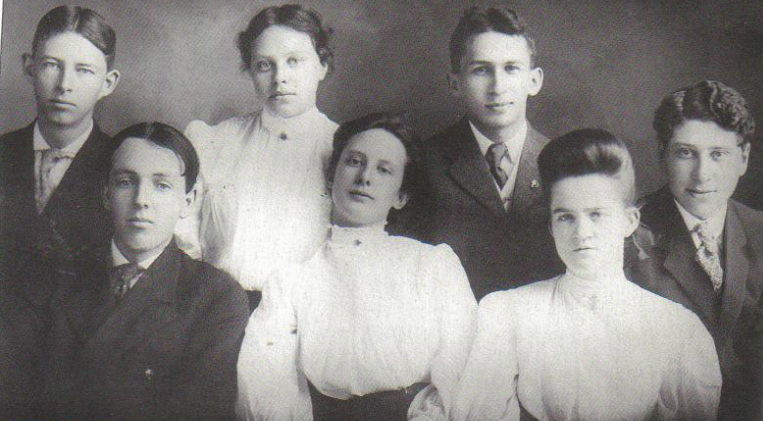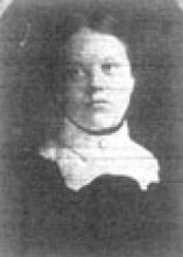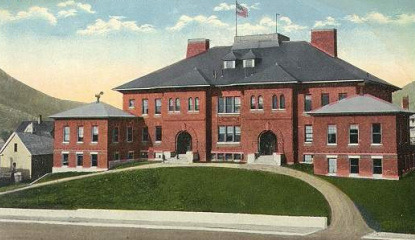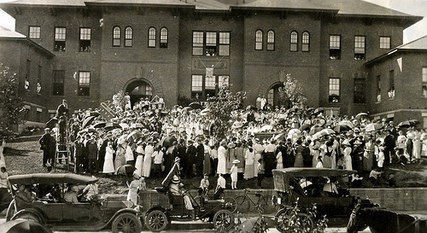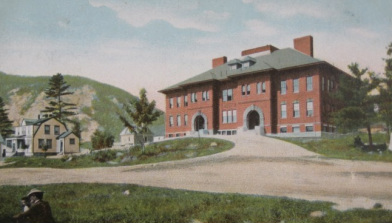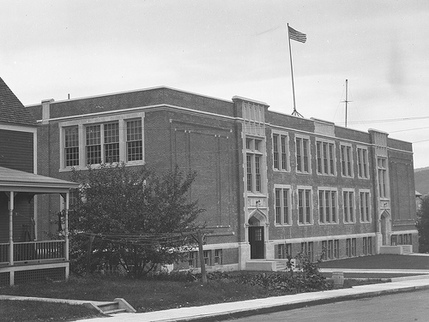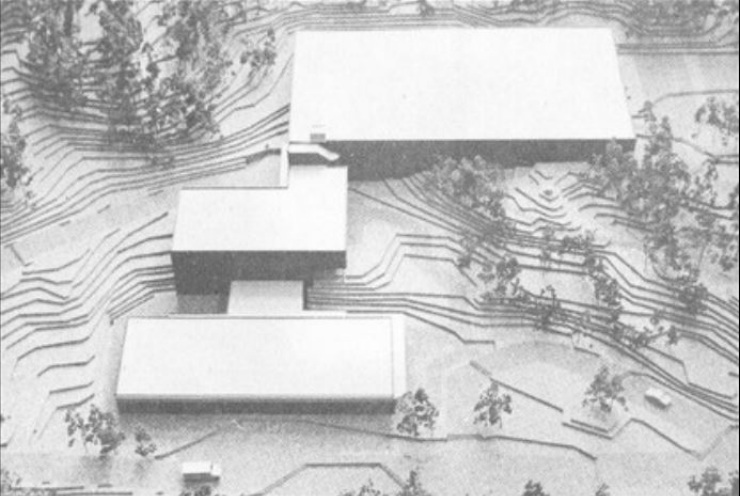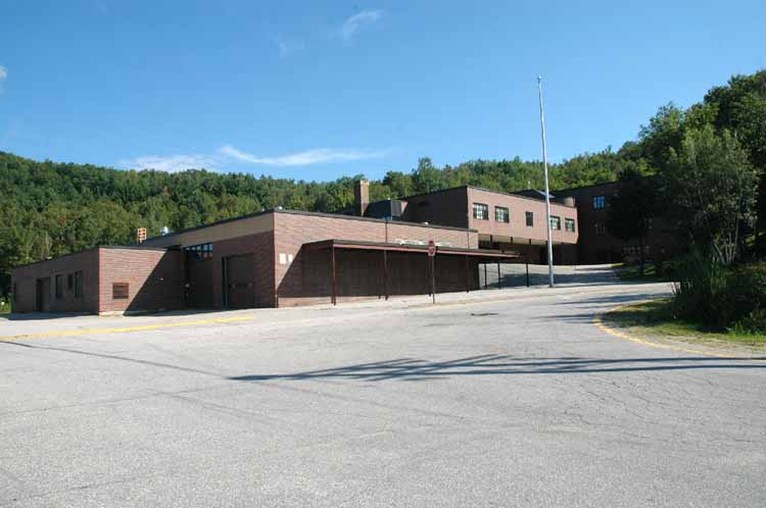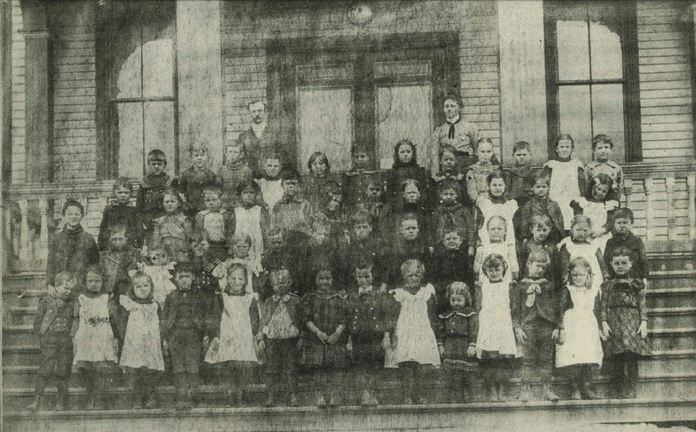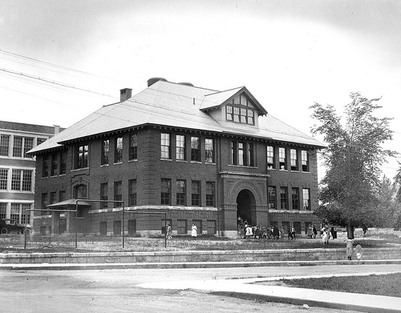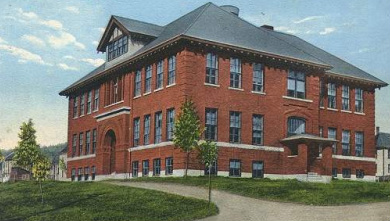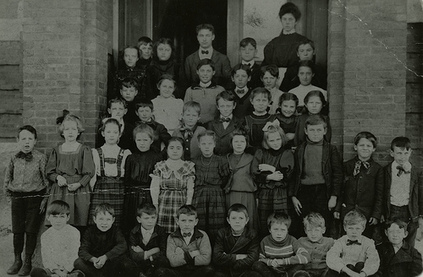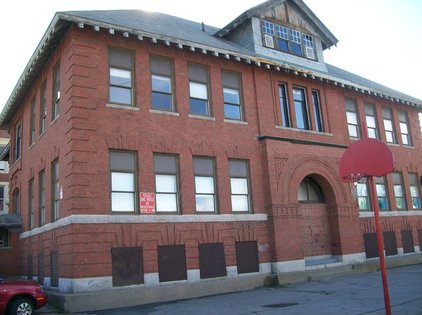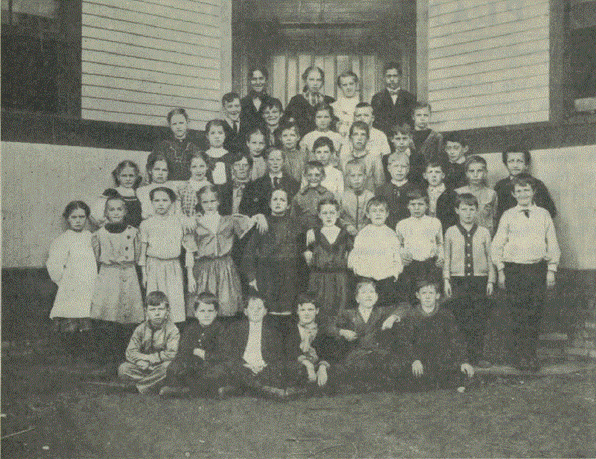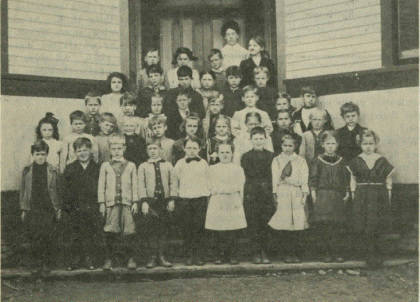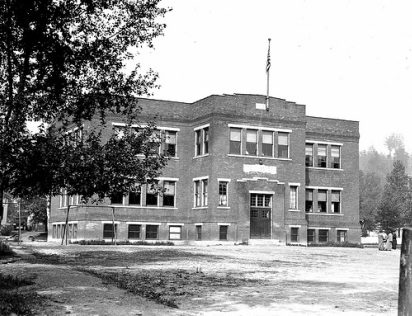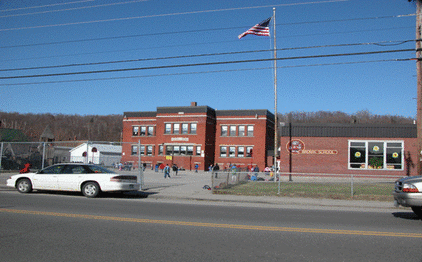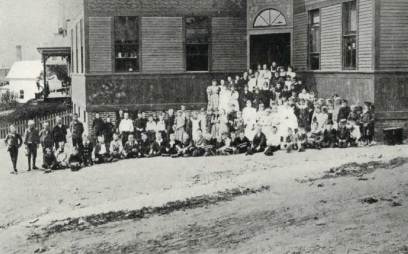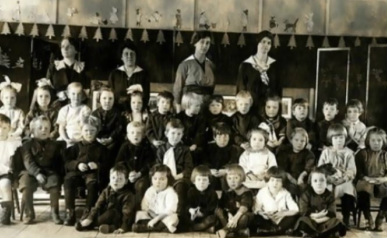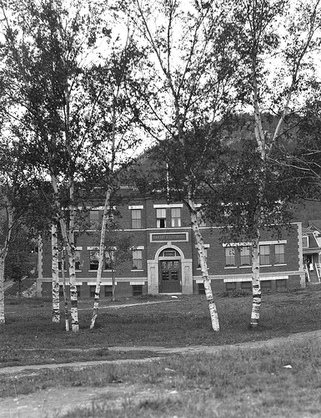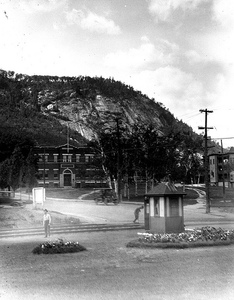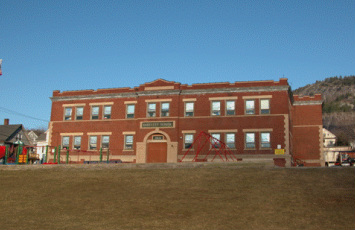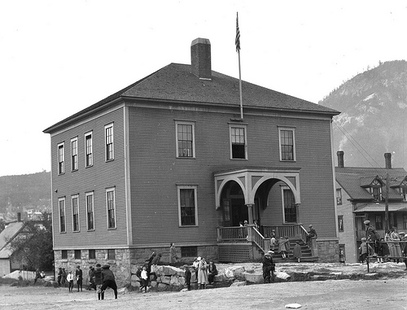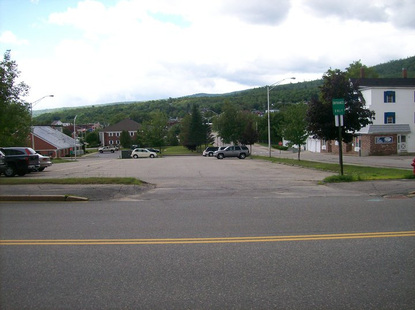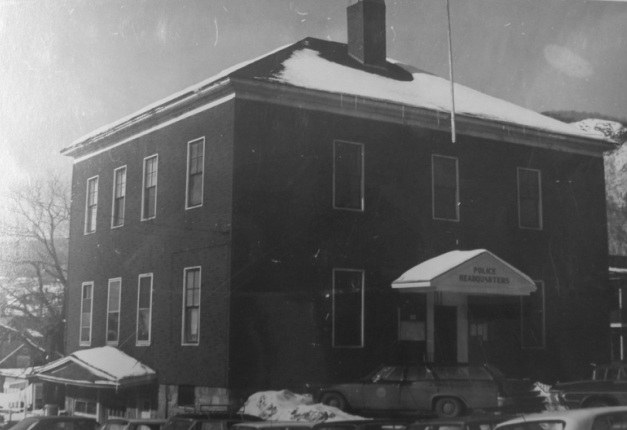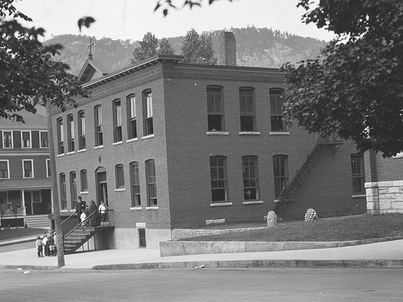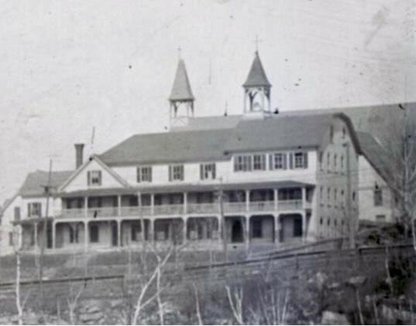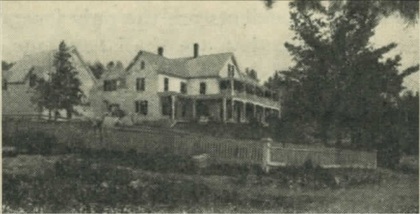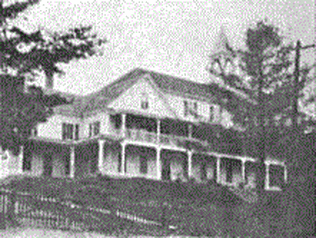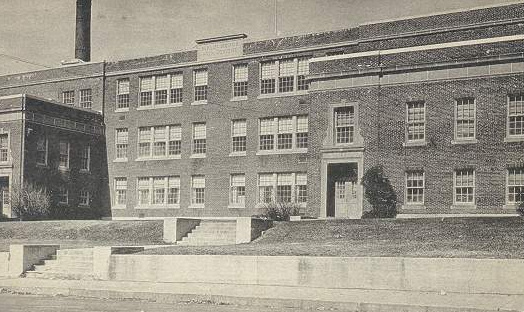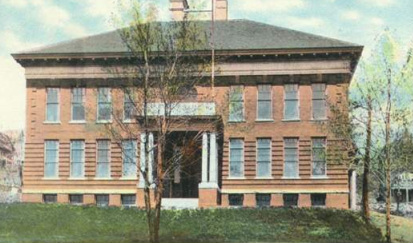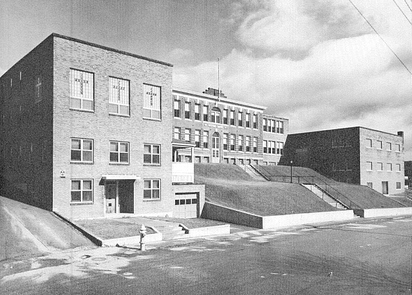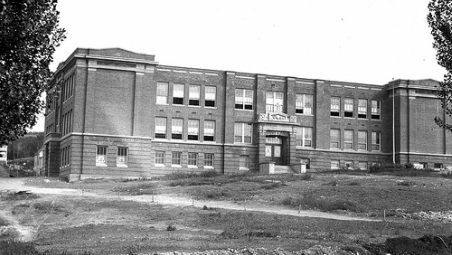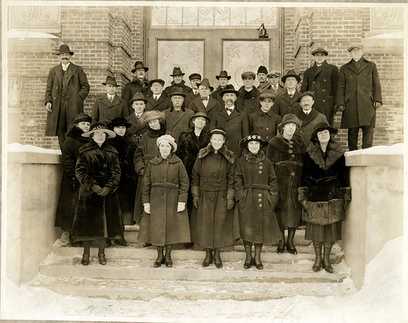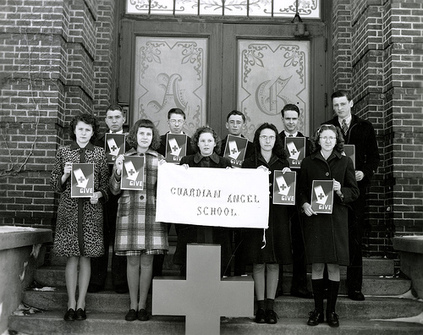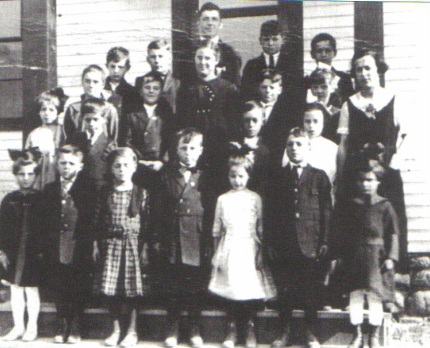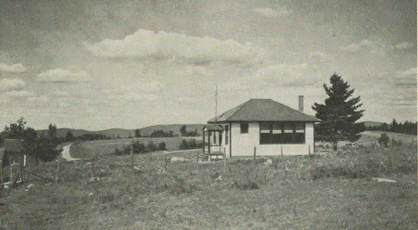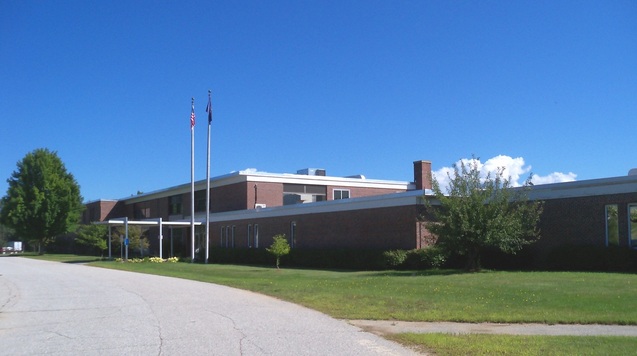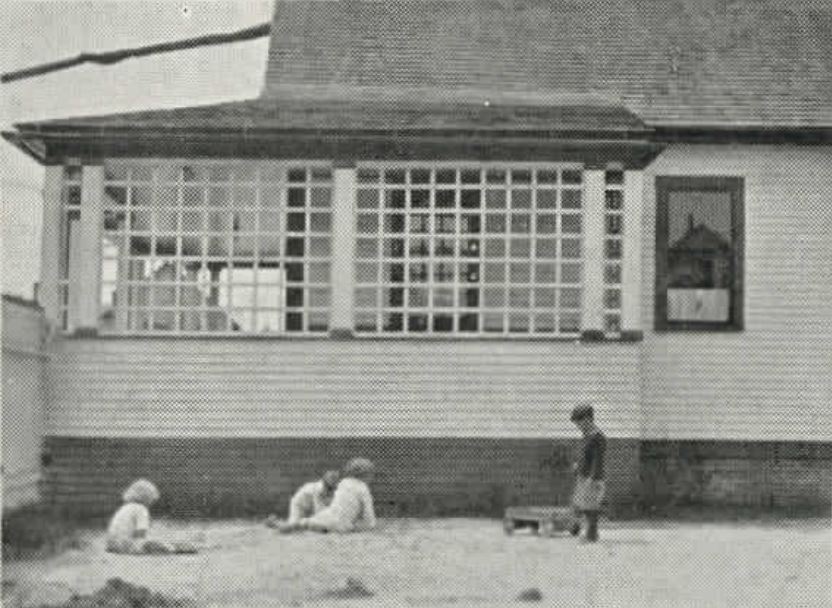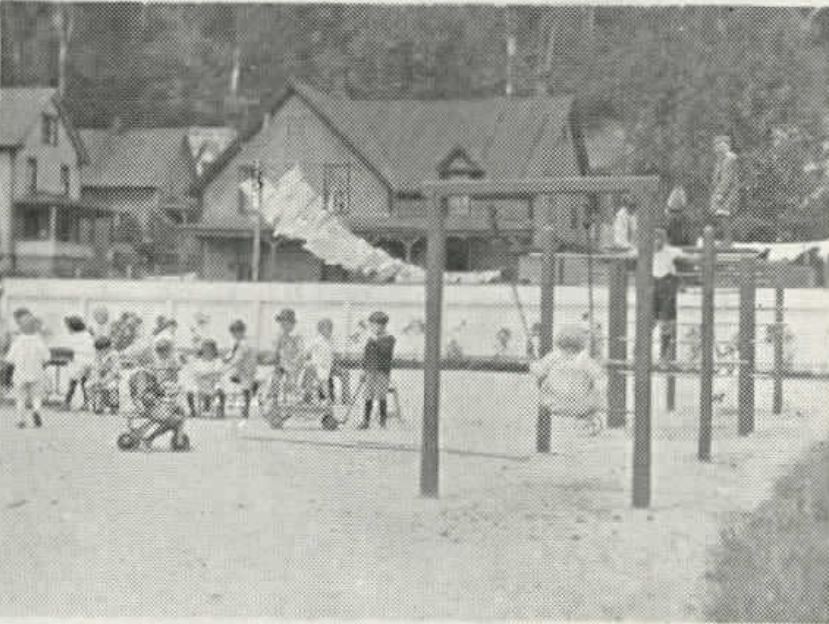Schools of Berlin New Hampshire
Berlin had many schools throughout its life time.The first school was taught in the corner bedroom of Thomas Wheeler’s house, which was a little bit south of the Twitchell farm, and was taught by Berlin’s first teacher, Rhoda Rowell. School wasn’t always taught in this house, instead, in Ms. Rowell traveled to many early homes and held class. In 1831, Samuel S. Thompson built the first school house on the bottom of Cates Hill Road.The small 9x11 one room school housed 25 students. The first public school was taught by the first male teacher in Berlin, Amos Angler Mann, and was paid $20.00 for the winter’s school. In later years, a school house called “The Little Red School House” stood on Mechanic Street, where the parking lot for the Northway Bank (Berlin City Bank) is today. The first Catholic School in Berlin was built by Benjamin and Elmire Jolicoeur. When they built their house, they had a special room where they put long tables and benches so the students had something the sit and write on. Mrs. Jolicoeur taught school until the first St. Regis Academy was opened. Thanks to Mrs. Jolicoeur, the coming of the French in Berlin can be traced. She wrote back home and told her people the better living to be had here. As they came to Berlin they would stay with Mr. and Mrs. Jolicoeur until they found a place to live elsewhere in Berlin.
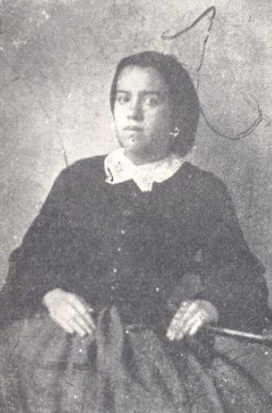
Elmire (Deluchez) Jolicoeur was born in Quebec City on September 18, 1844 to John Deluchez and Charlotte Gregoire. Mrs. Jolicoeur came to Berlin in 1864 and started the first catholic school in Berlin in her home. Latter she taught in the basement of the first St. Anne’s church. Mrs. Jolicoeur died at the home of her daughter, Nellie Seguin (628 Rockingham Street) on January 21, 1934, she was 89 years old.
The First Berlin High School
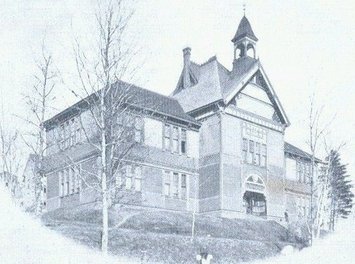
The first Berlin High School opened for students in February of 1885. It was situated on the exact same spot as the old Burgess school sits today. The first principal was Holman A. Drew and first assistant principal was Ms. Adria W. Dresser. Almost twenty years later, on December 15, 1904 on a Friday at about 6 p.m., the school had just closed for the three week long Christmas break. Mr. Currie, a custodian, went to the upper floors and saw that the walls were ablaze. Mr. Currie was the only staff member left in the school because all the teachers left, the last teacher left one-half hour before the fire. When the fire department got to the school there was nothing they could do to save this building because they were to high up on the hill to get good water pressure. The School was completely destroyed by the fire. It is said that you could hear the school bell ring when it fell and hit the ground.
For the rest of the school year, BHS students attended classes on the first floor of the Whitney Opera House on Mechanic Street and in the hall of the Tucker Block. In the fall of 1905, students had classes in the then newly constructed Central Fire Station on Main Street.
For the rest of the school year, BHS students attended classes on the first floor of the Whitney Opera House on Mechanic Street and in the hall of the Tucker Block. In the fall of 1905, students had classes in the then newly constructed Central Fire Station on Main Street.
The Second Berlin High School
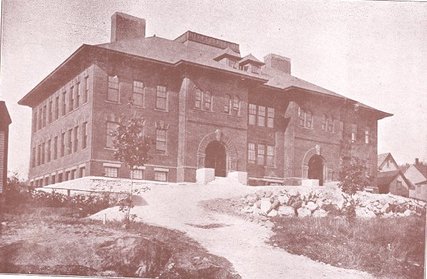
The second high school was situated on Hillside Avenue on the same spot as Hillside school stands now. The decision to build the second high school in this spot was because of the population growth, making it centrally located. The first graduating class was in 1906 with only seven students. One entrance was for boys and the other was for girls. This building lasted 17 years before succumbing to a huge fire during Easter of 1923.
The Third Berlin High School
The Fourth Berlin High School
In August of 1970, a model for a new high school building was drawn up by Dean M. Woodward of Auburn, Maine. A spot was chosen at the end of Willard Street and Madison Avenue. The bus entrance was originally spouse to be on Madison Ave. but is now on Willard Street (2013). The first levels would house shops such as building trades, welding, machine shop, and auto mechanics. The reason why the shops would be isolated from the rest of the classrooms is because this area would be too noisy to hold class next to them. The first level of the school would be connected to the rest of the school by a corridor. The building would also include two open areas outside, which most people use to call the “Upper Patio” (now closed up) and the "Lower Patio." When this school was first built, students and teachers would often be seen smoking cigarettes and eating lunch on these “Patios.”
Level two would include the kitchen, a dining area, an art room and gallery. A library was built above this area and rooms from distributive
education programs. The largest section of this school would be the third and forth levels. Level three would include classrooms for the English and History departments, offices, a gymnasium and locker rooms, with the gym extending up through the fourth level.
The remainder of the fourth level would house class rooms for business education, science laborites, math department rooms, and other classrooms. The third level would house the senior and junior halls, while the fourth would house the freshmen and sophomore halls. The school held
its first classes in the fall of 1972 and the first graduating class would be the Berlin High School class of 1973 with 314 students. This year (2013) would be the 40th anniversary of this class’s graduation and also makes the Berlin High class of 2013 the 40th class to graduate from this school.
Level two would include the kitchen, a dining area, an art room and gallery. A library was built above this area and rooms from distributive
education programs. The largest section of this school would be the third and forth levels. Level three would include classrooms for the English and History departments, offices, a gymnasium and locker rooms, with the gym extending up through the fourth level.
The remainder of the fourth level would house class rooms for business education, science laborites, math department rooms, and other classrooms. The third level would house the senior and junior halls, while the fourth would house the freshmen and sophomore halls. The school held
its first classes in the fall of 1972 and the first graduating class would be the Berlin High School class of 1973 with 314 students. This year (2013) would be the 40th anniversary of this class’s graduation and also makes the Berlin High class of 2013 the 40th class to graduate from this school.
The First Marston School

The first Marston School on the same spot as today's Marston School sits
The first Marston school was built in 1898 and named after the first mayor of Berlin, Henry F. Marston. The wooden building caught on fire on February 2, 1906. There were about three hundred students in the building at the time. It burned completely to the ground in less than two hours, without any loss of life. It was rebuilt by the end of the year and still remains in place today.
Brown School
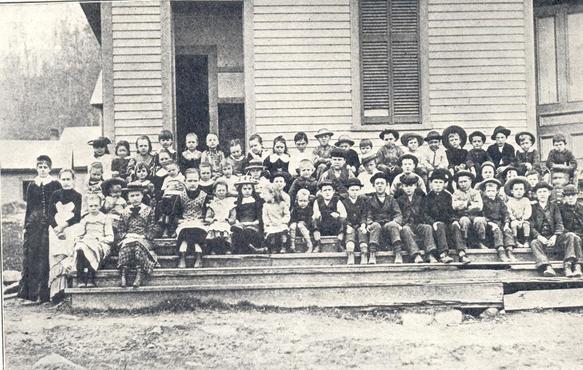
The Berlin Mills school district (district number 4) was formed around 1853. For many years school was taught in a large room adjacent to the Berlin Mills Company Store, which was across the street from the Brown Company day house (now know as the boarding house). In the 1870's, a new building was built at a cost of 1000 dollars that was a wooden building that sat on the same spot of what is now the parking lot of the vacant Clarkies Market. Here are some of the names of the people in this picture, front row seated, Mary Lambert, Lucy Lambert, Sophie Oleson, Miss Dooley, Os Sawyer, Paul Couture, George Brown, Fred Cote, Herb Clinch, Oscar Paulson, Wm. Oleson, Lewville Finsen, Bouchard, Stubby Oswell. Middle row: -2, Lenora Condon, 3 Minnie Oleson, 5 Clara Wardwell, 7 John Dooley, 8 Fred lambert, 9 Fred Couture, 10 Billey McCann, 11 Fritz Finsen, 12 Pete St. Clair, 13 Joe St. Clair, 15 Ed Bouchard. Back row:-4, Julia Johnson, 5 Jennie Olson, 6 Blanche Hobbs, 7 Susie McCann, 9 Miss Cote, 11 Lars Mortenson, 14 Adolph Boucher, 16, Joe Boucher, 17 Wm. Wardwell, 19, Mike McCann, 20 Walter Abbot, 21 Charles Murray. This photo was taken in 1884.
|
|
|
Bartlett School
The Cole Primary School
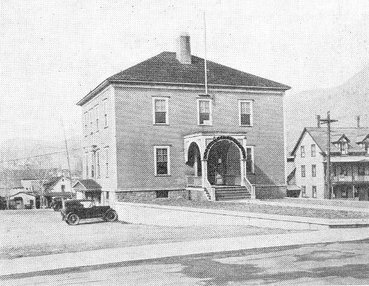
The Cole Primary School was built in 1895, which replaced the first Cole School that was moved almost across the street. In the late 1920’s it became Berlin’s police station, which before was in the basement of the City Hall. They remained there until going into the present building in the late 1960’s. The Cole School building stood almost across the street from where Coulombe Real Estate is today. It is now a parking lot. It was accessed from Mason Street and York Street.
St. Patrick's Catholic High School
St. Regis Academy (Catholic)
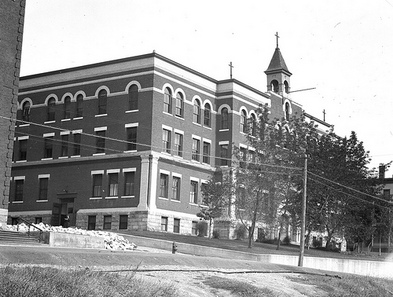
(Image from Beyond Brown Paper archives)
The first St. Regis building was first built by Henry Marston for his residence
in 1877. He then opened it up as a boarding house and called it the
“Whirling Eddy House”. This name came from a formation in the Androscoggin River nearby. It was created by a bend in the bank at that point, forming a large eddy.
Marston later renamed this place the “Cascade House”, running it as a small hotel and boarding house, until it was eventually bought by the Catholic Church. Additions were added on and it eventually opened on September 15, 1889 to four hundred students and called St. Regis Academy (Academy St. Regis). In 1911 the building was torn down and a beautiful brick structure replaced it. This new school was a monument to education in Berlin and paved the way for thousands of students to live good lives. Today that same building, which ceased educating students in the latter 1900’s, is now called Northern Lights, a housing facility.
in 1877. He then opened it up as a boarding house and called it the
“Whirling Eddy House”. This name came from a formation in the Androscoggin River nearby. It was created by a bend in the bank at that point, forming a large eddy.
Marston later renamed this place the “Cascade House”, running it as a small hotel and boarding house, until it was eventually bought by the Catholic Church. Additions were added on and it eventually opened on September 15, 1889 to four hundred students and called St. Regis Academy (Academy St. Regis). In 1911 the building was torn down and a beautiful brick structure replaced it. This new school was a monument to education in Berlin and paved the way for thousands of students to live good lives. Today that same building, which ceased educating students in the latter 1900’s, is now called Northern Lights, a housing facility.
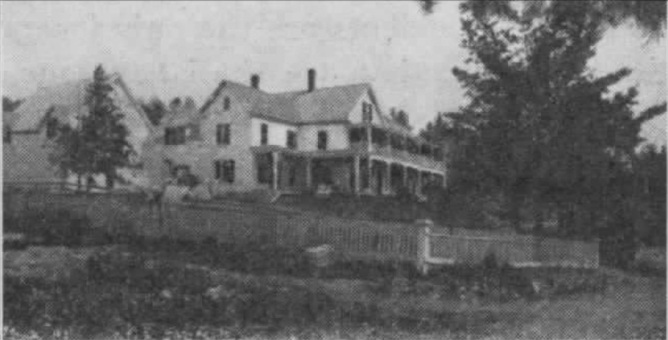
An early photo of the home/inn of Henry F. Marston, the Cascade House (Whirling Eddy House) .One must remember that these early inns were constantly expanded to fit the needs of the travelers to the early town of Berlin. The small Cascade House, which was built by Henry F. Marston, was completely different when the Catholic Church bought it to make the St. Regis School.
The First Sabbath School
The First Sabbath School was mostly Methodists and Batistes but no particular religion was required to participate in these meetings, because no churches of any kind were built yet in the town of Berlin. In June of 1836 the men, woman, and children of the small town of Berlin met at the schoolhouse and with the help of Mr. Samuel Blodgett, started the first Sabbath School which was more like Sunday bible studies. The time of meeting for the school was every Sunday at one o’clock. Mr. Thomas Wheeler and Mr. Benjamin Bean always began class with prayer.
Berlin Junior High School (Hillside School)
The Burgess School, latter named Notre Dame Catholic High School
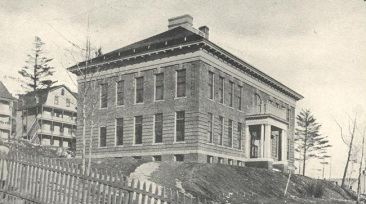
The George E. Burgess School was built in 1905 on the same spot as the first Berlin High School, which burned to the ground in 1904. By January of 1906 the Burgess School started operation, housing the lower grades. Eleven years later in 1917, fire again struck the school on the hill and when all was said and done, only four walls were standing. These walls were saved and the building was rebuilt. By 1941, this building was no longer being used for education and housed the WPA sewing projects and federal commodities depot. With the Catholic parishes looking for a place to build a high school, the Reverend O.F. Bousquet requested in a letter to the city that they were interested in the WPA building. On September 9, 1941 the building was now opened as Notre Dame High School, with 140 students and the first graduating class was in 1943. Several additions were made and this school operated for thirty one years. After closing its doors, it once more took on the name of Burgess School and housed lower grades until final being closed for good.
St. Joseph's Catholic School
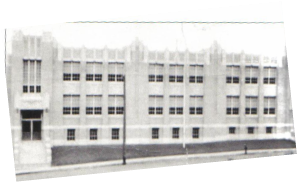
St. Regis Academy was starting to get overcrowding and to fix this problem the Catholic Church built a new school for the students from the Avenues. The St. Joseph School was built in 1930 and all the teachers there were French-Canadian Sisters of the Presentation of Mary from Quebec. The school closed in 1971.
Guardian Angel Catholic School
The Cates Hill Schoolhouse
The Russian Orthodox School
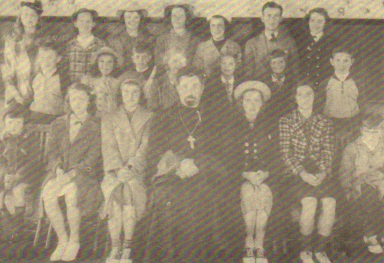
The school in 1940
At the Russian Orthodox Church , the focus was on the youth of the children in the parish. They held class in the basement of the church. That is where the children learnt how to read and write in both English and Russian. They also learnt basic things like math, science, and history.
The St. Louis Hospital School of Nursing
The St. Louis Hospital was considered one of the top nursing schools in New Hampshire. When the students gradated the program ceremonies were held at the Berlin High School auditorium (now the Junior High.)
King School
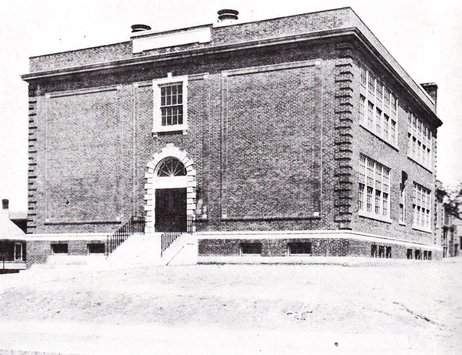
(Image from Poof Tardiff)
King School was named after mayor Eli J. King, who was in office at the time. It opened in 1928 and closed in 1971 and was also the only public school on the East-side. The School also housed in its basement the number four fire station, which closed eight years after the school in 1979. Today the old school is the location of the St. Vincent de Paul Thrift Shop, or East-side mall.
The White Mountain Community College
The Brown Company Kindergarten
The Brown Company kindergarten was founded around 1883 by Mrs. Emily Jenkins Brown, wife of W. W. Brown. The idea of the kindergarten was to provide free kindergarten to the children of Brown Company employees. The first person in charge was Mrs. H. J. Brown and class was first held in the basement of the Congregational Church on Main Street. It was later moved into a building that later held the company offices and then moved to a building on Main Street.
Mrs. Burgess was one of the early teachers, and Mrs. George H. Fowler, who later became a member of the Berlin School Board, served sixteen years as a teacher while Mrs. O. B. Brown was in charge. When Mrs. W. R. Brown was head, the kindergarten was redecorated and made very attractive for the children. In 1922, a new playground was added and modern apparatus modeled from leading New York schools. It’s too bad Berlin didn’t have this wonderful kindergarten still going strong.
Mrs. Burgess was one of the early teachers, and Mrs. George H. Fowler, who later became a member of the Berlin School Board, served sixteen years as a teacher while Mrs. O. B. Brown was in charge. When Mrs. W. R. Brown was head, the kindergarten was redecorated and made very attractive for the children. In 1922, a new playground was added and modern apparatus modeled from leading New York schools. It’s too bad Berlin didn’t have this wonderful kindergarten still going strong.
